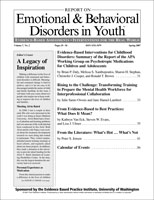Describing Types of Student Engagement for High School-Aged Youth Identified by Schools as Having Challenging Emotional and Behavioral Problems
Author: Kelly E. Monahan.; Emily B. Mancil.; Melissa W. George.; Steven W. Evans.; Mark D. Weist.
Source: Volume 15, Number 01, Winter 2015 , pp.10-17(8)

< previous article |next article > |return to table of contents
Abstract:
Approximately 12% to 13% of school-aged youth in the United States experience academic difficulties related to emotional and behavioral disorders (EBDs), including failing grades, truancy, suspensions and expulsions, and nearly half of these youth ultimately withdraw from school. Student engagement (SE) is posited to be critical in preventing school disconnection and withdrawal and has been shown to affect achievement, school behavior, and school completion for youth with EBDs. Although there are four types of SE—behavioral, academic, psychological, and cognitive—associated with dropout and success for students with EBDs, the psychological and cognitive components are often neglected in current research and in assessment and identification practices in schools. This paper describes these four types of SE for a sample of 647 high school students identified with severe emotional and behavioral problems. Comparisons of engagement based on symptom severity indicated that youth with severe behavioral problems report less engagement in all four areas and that youth with severe emotional problems experience less cognitive and psychological engagement than youth with less severity. These findings suggest that youth with EBDs who are experiencing significant emotional problems may also be experiencing difficulties with cognitive and psychological engagement, which may not be captured by relying on behavioral and academic indicators. Understanding differences in types of student engagement for youth with EBDs may improve early identification of disconnection or withdrawal from school and have critically important implications for early intervention and school retention of youth with EBDs.Keywords: Emotional and behavioral disorders, EBD, student engagement, youth, adolescents
Affiliations:
1: Villanova University; 2: University of South Carolina; 3: University of South Carolina; 4: Ohio University; 5: University of South Carolina.